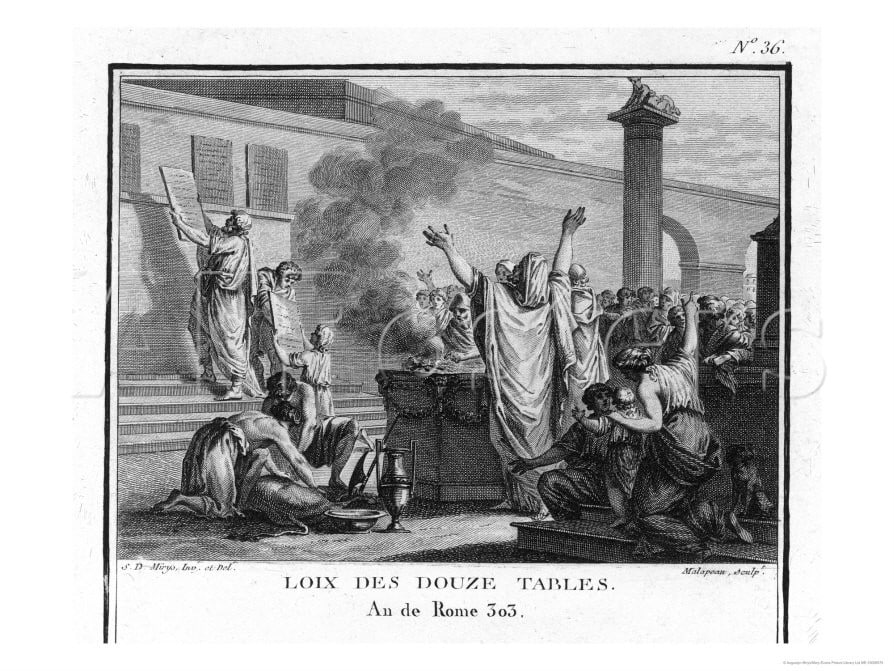In the late 1780s, after the United States had formally concluded peace with Britain and secured its independence, the lawmakers who formed the Second Continental Congress and issued the Declaration of Independence in 1776 faced new problems.
The United States was now free of foreign oppression but needed a constitution and ancillary laws. The constitution was worked out in the late 1780s, alongside another document known as the Bill of Rights.
James Madison wrote it, forming the basis for the first Ten Amendments to the US Constitution. What’s curious about this is that the Bill of Rights, as Madison put it together, was heavily influenced by a text written over 2,000 years earlier.
This was The Laws of the Twelve Tables, a law code that was promulgated in Rome in 449 BC.
Why one might ask, was Madison influenced by this antique law code? What was in it that made it still relevant when the United States was coming into being?

The Early Roman Republic
Before assessing the Twelve Tables and the laws enshrined within them, it is important to understand the context in which the Romans wrote them. Rome, so the myth goes, was founded in 753 BC by Romulus and Remus on the banks of the River Tiber.
It was initially a monarchy ruled by Romulus after he killed his brother Remus. Seven monarchs supposedly reigned there for a suspiciously long time of nearly 250 years before the seventh king, Lucius Tarquinius Superbus, a tyrant, was overthrown in 509 BC by the Roman people. After that, people established the Roman Republic.
Rome already had some laws by this time, notably those established by Romulus and the second Roman king, Numa. However, the Roman Republic needed a more elaborate law code, duly said to have been developed and promulgated in the mid-fifth century BC.
As described by the first century BC historian, Livy, the immediate motive in doing so was increasing tensions between the patrician class of Roman aristocrats and landowners and the plebeians or poorer citizens.
In this context, the Roman Senate appointed a decemviri, a board of ten men, to draw up a new set of laws around 450 BC. These ten men, according to Livy, were even sent to the grand home of democracy and republic at that time, Greece, to study the best legal systems there and use them as the basis for the new laws in Rome.
This is probably a fanciful tale designed by Livy to establish links between Rome and Athens hundreds of years later. However, it is possible that the Greek city-states heavily influenced the Romans.
Whatever the truth of this, we know that the decemviri were said to have drawn up Ten Tables by the end of 450 BC, to which two more were added the following year, before they were all inscribed on bronze tablets and set up for all to view in public places in the city of Rome.
The Twelve Tables of the Laws
The Twelve Tables concerned a wide range of issues. The first was related to how the courts should operate and trials proceed. The idea was that in formalizing these and making the process known to all Romans, the richer patrician class could not abuse the plebeians of their rights as Roman citizens.
The second and third table elaborate further on these. The fourth table is related to the paterfamilias’ rights or the household head. Some elements of this were brutal.
For instance, it called for disabled children to be euthanized by leaving them exposed in the wilderness, a practice which was unfortunately all too common throughout Roman history.

The fifth and sixth tables primarily concerned the rights of women and their place in Roman society. These were liberal in some ways, in that Roman women could inherit property and land, a rarity in other parts of the Mediterranean at the time.
Further issues concerned the place of enslaved people within Roman society or how disputes between Roman citizens would be resolved. For instance, the seventh tablet outlined how boundary disputes between lands would be resolved through the arbitration of a third party. It also showed how property owners could request an individual remove a tree from their land if it fell into their land from another farm or property.
The eighth tablet dealt with issues of theft and how it was to be prosecuted extensively, while religious and public laws were covered in the later tables. All in all, the Twelve Tables outlined a detailed set of laws for both private and public matters.
Continuity and Legacy
The Twelve Tables continued to influence Roman law for hundreds of years. However, the Roman legal system did evolve. It became more complicated over time, notably so between the third and first centuries BC, when Rome’s rapid expansion massively changed the social and economic situation of the Roman Republic.
Some of their essential elements, though, were retained, particularly the belief in equality before the law for free Roman citizens, whether one hailed from the patrician or the plebeian class.
Thus, elements of them were still being used down to the end of the Roman Empire and were enshrined in the famous law codes of Emperor Justinian in the early sixth century AD.
They consequently formed part of the civil law, which continues to influence legal systems throughout the world today and influenced Madison to draw up the Bill of Rights in the 1780s.
In particular, the parts of the Twelve Tables, which deal with legal procedure, how a plaintiff is prosecuted, and how trials should proceed, have had a lasting impact on legal processes over the last two and a half millennia.

